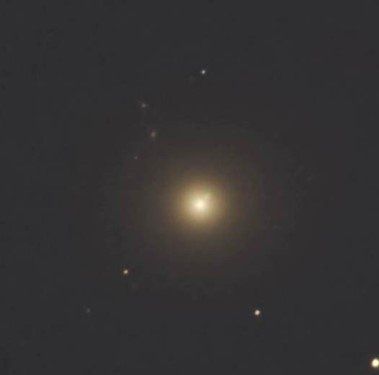DSO of the Month :
Messier 87
AKA: NGC 4486, Virgo A, Virgo X-1
Position: 12 hr 30 min 50 sec +12 degrees 23 min 28 sec
Due south at 23:56 (BST) on 15 April 2022
Messier 87 – note the jet at the centre
Image: Les Brand, HAS member. Used with permission.
I am always reluctant to include galaxies as they are usually impossible to observe in our light-polluted skies; and even when you can observe them, they are often no more than a dim smudge. However the Spring has become known as the “galaxy season”, mainly because of large Dobsonians being used in very dark areas of the United States. But as a nod to “galaxy season” I am covering Messier 87 this month. Let me say straight off that I would be surprised if you can see M87 in Havering, but use the biggest telescope you can lay your hands on and go to the darkest possible site; to some extent two incompatible suggestions! Charles Messier himself just had a four inch telescope, so we can only hope and try. Messier observed M87, almost certainly as a dim smudge, in 1781 and for many years it was regarded as a rather dull and unclassifiable “nebula”, given the lack of any detail. Even after Hubble showed that such nebulae were well outside the Milky Way, M87 simply became an extragalactic nebula.
We now know it is an elliptical galaxy, probably formed by the merger of two or more spiral galaxies which then coalesced into a uniform ball of stars. The same fate awaits the Milky Way when it collides with the Andromeda Galaxy in five billion years. M87 lies at the centre of the Virgo cluster, our nearest galactic cluster. Galaxies in such clusters are prone to collisions and hence these clusters contain a large number of elliptical galaxies. M87 is the most massive galaxy known in the local universe, probably as a result of eating a lot of other galaxies. Although it is about the same size as the Milky Way, it has twice its mass. It has a similarly massive black hole at its centre, which is now estimated at 6.5 billion solar masses; by contrast the Milky Way’s black hole is a mere 4.3 million solar masses. There is a plasma jet shooting out of the accretion disk of this monster black hole at velocities close to the speed of light. The shadow of this black hole (NB: not the black hole itself) was famously imaged by the Event Horizon Telescope in 2019. M87 is also a strong source of gamma rays. This galaxy lies 53.5 million light years away, which is fairly close for a galaxy.
In principle it is fairly easy to find M87 in the sky. It lies in the constellation of Virgo, on a line between Denebola and the 2.8 magnitude star Vindemiatrix (Epsilon Virginis), about a third of the way along from Vindemiatrix. The complication is that there are several other elliptical galaxies of similar brightness on the same line; notably M60 which is closer to Vindemiatrix. Five stars in Virgo – Epsilon, Delta, Gamma, Eta and Nu – form an asterism called the Bowl of Virgo which is filled with galaxies; M87 is on its northern edge. The whole galaxy is about 7 arcminutes across and you may be able to make out the bright core which is 45 arcseconds wide. It is relatively bright (magnitude 8.8) and compact, which should help. Good luck!
ARCHIVE
